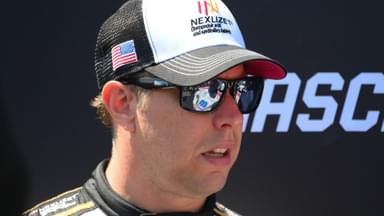Chris Buescher doesn’t pull punches. When the Roush Fenway Keselowski Racing driver is asked a question by the media, he gives a thoughtful, honest, and transparent answer, even if it isn’t the most popular one in the eyes of NASCAR or his fellow drivers and teams.
Advertisement
One of the hottest topics in the Cup Series over the past few weeks has been the specter of potential race manipulation. If someone can come up with something clever and sneaky to give themselves or their teammates an advantage, they’re probably going to do it. That has been a NASCAR hallmark for more than three-quarters of a century.
During his media availability this week prior to Sunday’s Cup playoff race at Talladega Superspeedway, Buescher was asked about what can and can’t be said over team radio. Although he isn’t in contention after missing the playoffs this season, the Texas native addressed how certain comments might be perceived by those listening in — particularly NASCAR officials — who could interpret them as signs of potential race manipulation.
“I think it did make a difference,” Buescher said after hearing NASCAR officials caution teams last weekend in Las Vegas. “I don’t have any direct communication for what’s been talked about, but I know it has made it through our competition side.
“I know that (the topic of race manipulation) has made it into the media and I think the message we’ve gotten is clear enough to say, ‘Do it at your own risk, but you’re not gonna like the result? Ultimately, I think that’s fair.”
Buescher recalled an incident last year at Martinsville that still sticks in his mind and raises questions about whether race manipulation may have taken place.
“We had a terrible scenario at Martinsville last year with cars just riding and blocking basically the entire racetrack,” he said. “We’ve had instances where we’ve seen cars just straight-up lift and not push rows at speedway races. I don’t know if that’s blatant enough to be called this time around if there is radio chatter ahead of that, I don’t know.
“It’s a hard line for anybody to police and you can always say that balance was an issue.”
Different Verbiage Can Also Have Different Meanings or Interpretations
There’s also the matter of how comments made over the radio between the driver, crew chief, and spotter are perceived in terms of meaning and intent.
“I heard one of the things that came from the ROVAL was something that I actually got told in a purely selfish 17 team state of mind was, ‘Alright, save tires here. Don’t push forward in case we have a late-race restart.’ And then I hear that was one of the things that somebody else said later on that almost got them in really big trouble,” Buescher continued.
“So I’m sitting here like, ‘Well, alright, we realistically wanted to make sure we had some amount of tire race (left) for a late-race restart.’ That was not to help anybody other than ourselves, so it’s certainly a hard place to officiate from. But I think that the warning is loud enough and clear enough that nobody wants to be on the other side of NASCAR having to make a judgement call.”








